When I first brought my jade plant home, I watered it every day — within two weeks, its leaves turned yellow. That’s when I learned: jade plants hate love in excess.
Jade plants have earned a reputation as low-maintenance indoor companions, yet watering mistakes cause 80% of beginner failures across Indian homes. The problem isn’t the plant — it’s understanding its unique water needs.
Indoor gardening is booming in Indian cities, with more apartment dwellers turning balconies and living rooms into green sanctuaries. Jade plants perfectly suit this trend: they’re compact, beautiful, and incredibly forgiving once you crack their watering code.
This guide reveals the exact jade plant watering tips that have kept my collection thriving for five years. You’ll discover the perfect watering schedule, seasonal adjustments for Indian climates, placement strategies, and common mistakes that kill these resilient succulents. By the end, you’ll water with confidence, not guesswork.
💧 Quick Guide: Water every 7–10 days in summer, once every 3–4 weeks in winter. Use finger test before every watering.
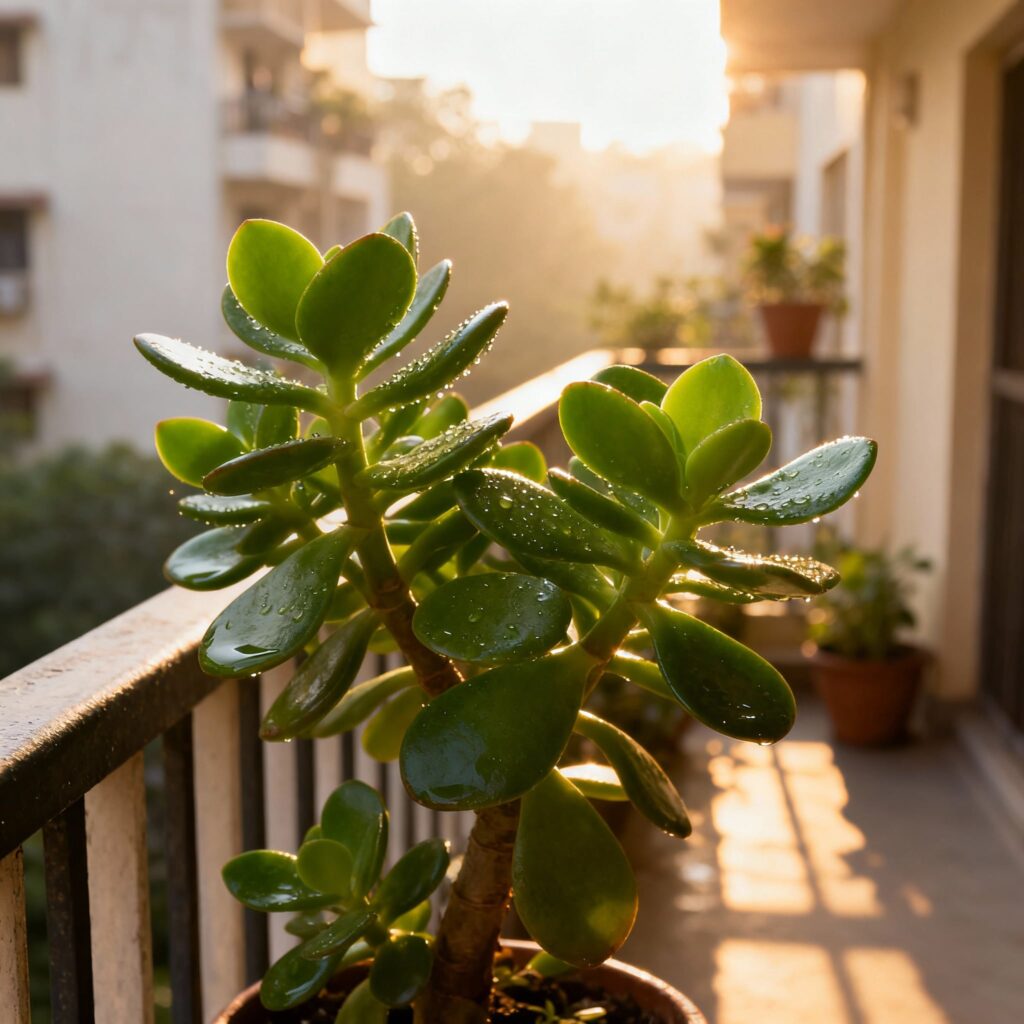
Understanding Jade Plant Water Needs
Jade plants need watering only when soil is completely dry, typically every 7-10 days in summer and 3-4 weeks in winter. Unlike regular houseplants, these succulents store water in their thick leaves and stems, making them drought-tolerant but vulnerable to overwatering.
Jade plants (Crassula ovata) belong to the succulent family, native to South Africa’s dry regions. Their thick, glossy leaves act as water reservoirs, allowing them to survive weeks without irrigation. This adaptation makes them perfect for busy Indian professionals who travel frequently or forget watering schedules.
However, this same feature creates confusion. Many beginners treat jade plants like tropical houseplants, watering them 2-3 times weekly. This drowns the roots and causes irreversible damage within days.
Indian climates add complexity. Monsoon humidity in Mumbai differs drastically from Delhi’s dry winters or Chennai’s year-round warmth. Jade plants require adjusted care based on local humidity and temperature fluctuations.
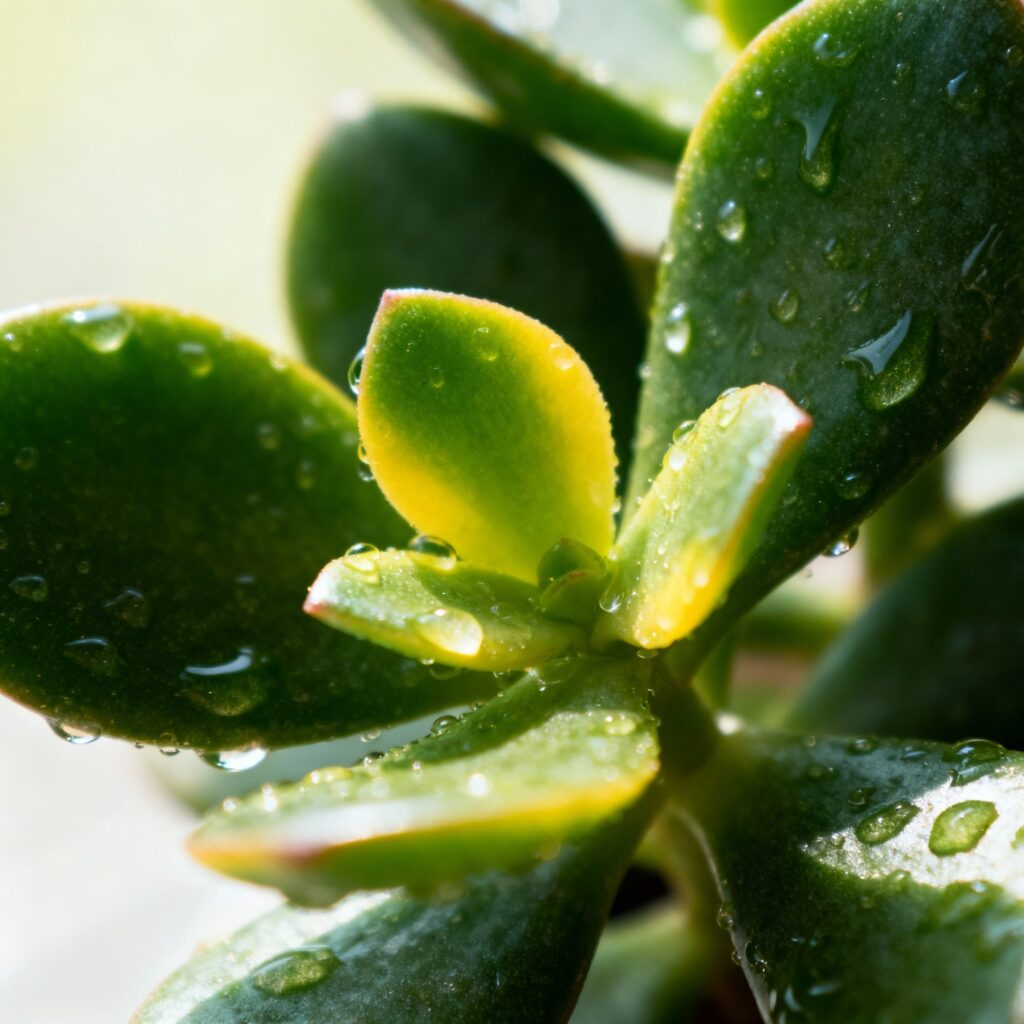
Reading Your Plant’s Signals
Learning to read your plant eliminates 90% of watering mistakes.
Overwatering warning signs appear first in the leaves. They turn pale yellow, feel soft or mushy when touched, and may develop black spots. The stems become squishy near the soil line. Sometimes you’ll notice a foul smell from the pot — that’s root rot setting in.
Underwatering symptoms look completely different. The leaves wrinkle and develop thin, crispy edges. They might drop off easily when touched. The plant appears deflated, and soil pulls away from pot edges. Underwatering rarely kills jade plants — they bounce back quickly with proper hydration.
The finger test remains the most reliable method. Insert your finger 2 inches deep into the soil. If it feels even slightly damp or cool, wait. Water only when it’s bone dry and warm.
💡 Quick Tip: Use the “lift test” — pick up your pot weekly. A light pot means dry soil and it’s time to water.
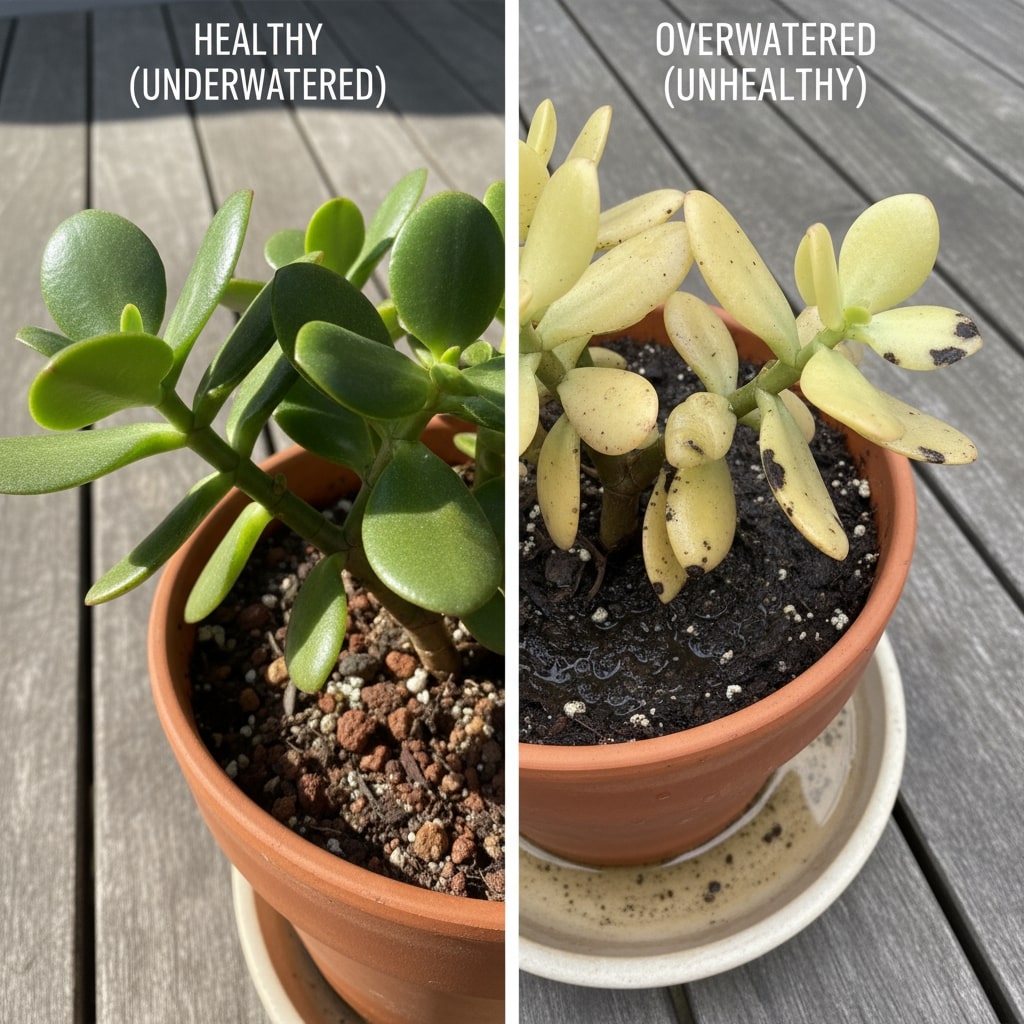
Best Way to Water Jade Plant Indoors
The best way to water jade plant indoors is using the “soak and dry” method: water deeply until it drains from bottom holes, then wait until soil is completely dry before the next watering. This mimics natural rainfall patterns and encourages strong root development.
The Soak and Dry Method Step-by-Step
First, check soil moisture using your finger or a moisture meter. Never skip this step, even if you think it’s time to water. Indian weather changes quickly — what worked last week might not apply today.
Use room temperature water stored overnight. Cold water from the tap (especially in winter mornings) shocks roots and can cause leaf drop.
Water deeply and thoroughly until excess drains from bottom holes. Don’t just sprinkle the surface — that encourages shallow roots. Pour slowly in a circular motion around the pot’s perimeter, not directly at the stem.
The soak method involves letting water fill the saucer for 10 minutes. This allows the plant to absorb exactly what it needs through drainage holes. After soaking, empty the saucer completely. Jade plants sitting in standing water develop root rot within 24-48 hours.
Wait 2-3 minutes, then empty any remaining water from the saucer. This step is crucial for preventing fungal problems.
Never water on a fixed schedule. Plants don’t follow human calendars. Factors like humidity, temperature, pot size, and growth stage all affect water needs.
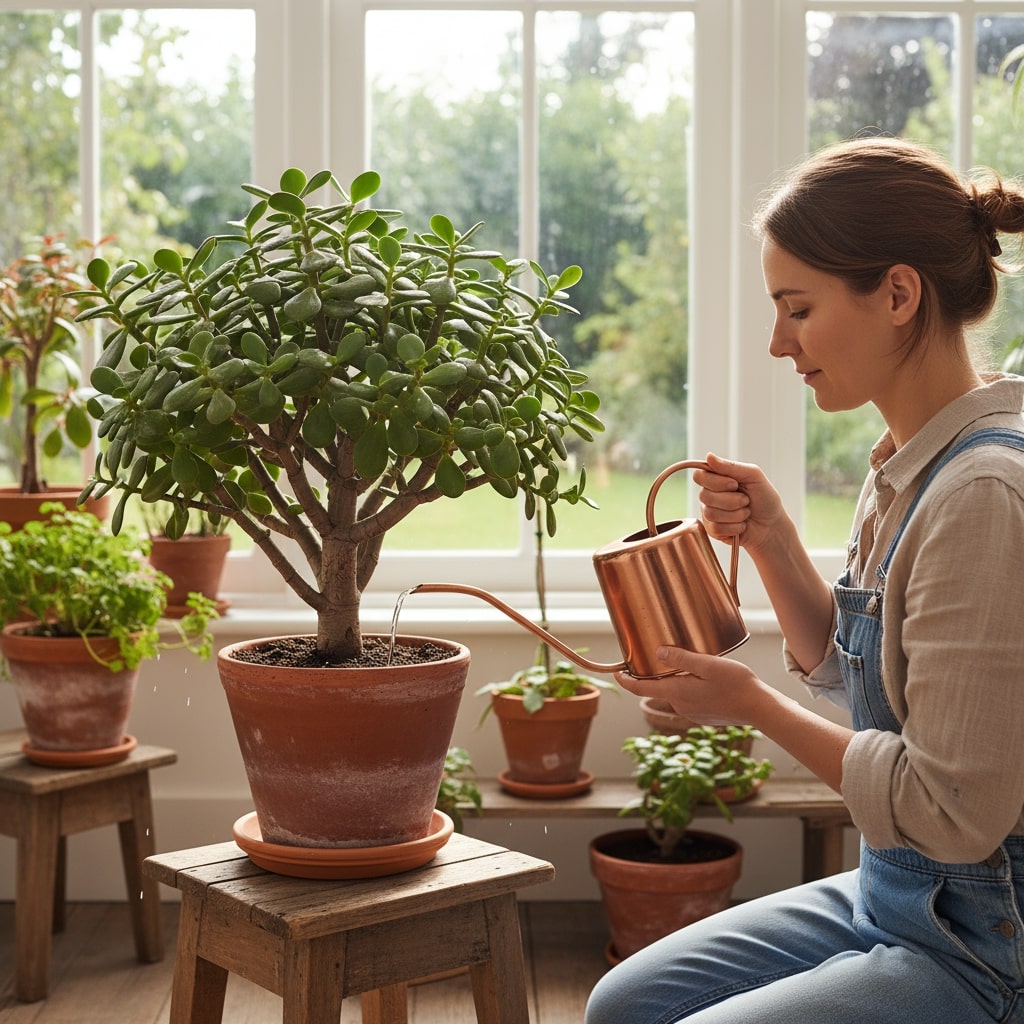
Essential Indoor Watering Tools
Long-spout watering cans prevent splashing on leaves and give you surgical control. A 1.5-liter can with a 6-inch spout reaches under foliage without disturbing the plant.
Soil moisture meters eliminate all doubt. These inexpensive devices (₹400-700) have three prongs that measure moisture deep in the root zone. Insert it halfway down your pot — if it reads “dry,” water; if “moist,” wait.
Well-draining terracotta pots breathe better than plastic, allowing excess moisture to evaporate through porous walls. In humid Indian climates (especially coastal cities), this makes overwatering nearly impossible.
Bottom watering is another effective indoor method. Place your jade plant pot in a tray with 2-3 inches of water for 10 minutes. The plant absorbs exactly what it needs through drainage holes — no runoff, no waste.
💡 Quick Tip: Set a monthly reminder to check your jade plant rather than a weekly watering alarm. This trains you to observe the plant instead of following a schedule.

Where to Place Jade Plant in Home
Where to place jade plant in home directly impacts its watering needs and overall health. Place jade plants in east-facing windows or south-facing balconies with 4-6 hours of bright, indirect sunlight. Proper placement ensures plants use water efficiently, while poor locations cause soggy soil and root problems.
Best Locations in Indian Homes
East-facing windows provide gentle morning sunlight without harsh afternoon heat. This orientation is ideal for most Indian cities. Jade plants placed in east windows get 4-5 hours of morning sun daily — perfect for healthy growth.
South or southeast windows work well with sheer curtain protection during peak summer (March-June). Direct afternoon sun can scorch leaves, creating brown spots. Southeast direction is considered especially auspicious as per Vastu for attracting wealth and prosperity.
Living room placement promotes happiness, harmony, and family bonding. Position the jade plant in the living room to enhance the flow of positive energy, benefiting the social and familial atmosphere.
Near the entrance is one of the most auspicious places to place a jade plant. This spot invites financial luck, business success, and prosperity according to Vastu principles. The north entrance is particularly favorable for wealth attraction.
Balcony or patio in north or east direction brings in the flow of positive energy and growth. These outdoor spots provide excellent light while protecting from harsh afternoon sun. Jade plants on balconies get natural air circulation, reducing fungal problems during monsoon.
Office desk placement promotes focus and decision-making. Keeping a jade plant in an office setting results in success, prosperity, and wealth in business according to Feng Shui principles.
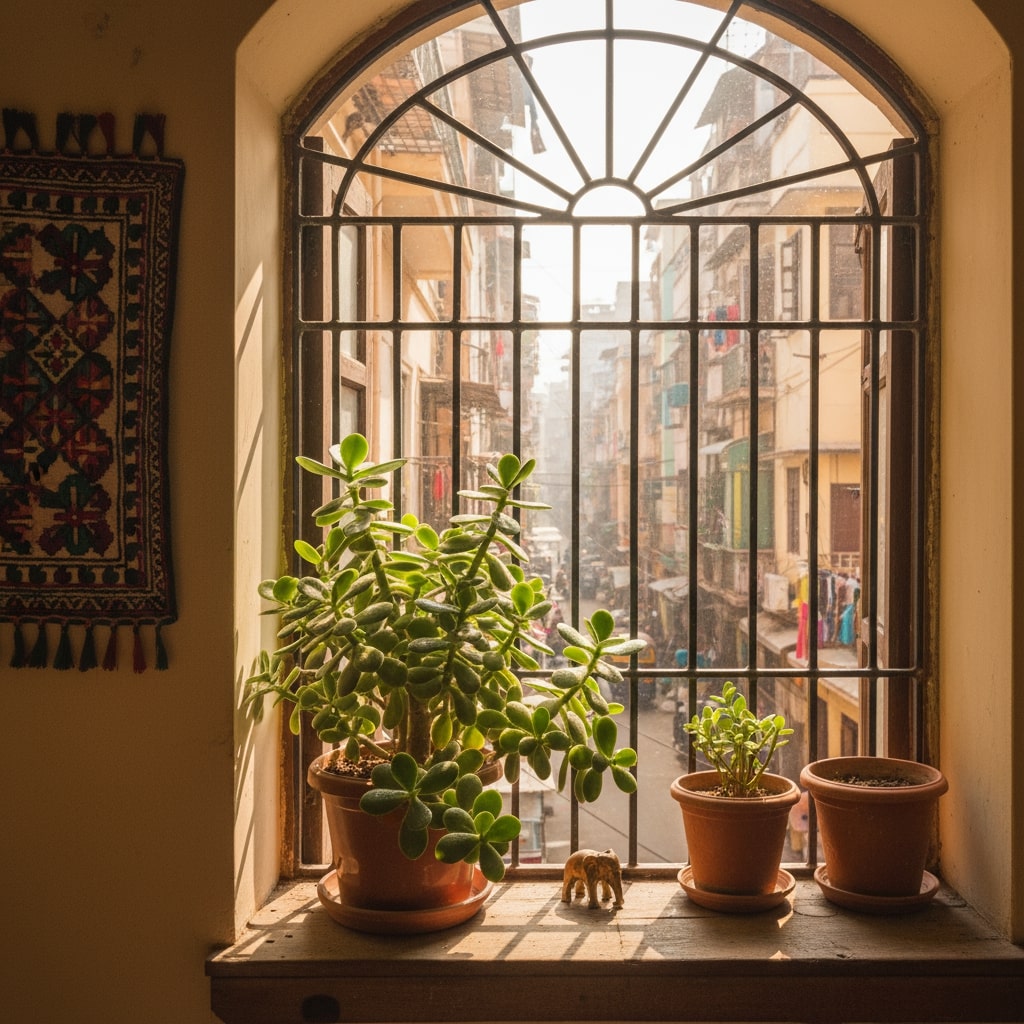
Places to Avoid for Jade Plants
Bathroom placement drains wealth and energy according to Vastu. It flushes away prosperity and positive energy, plus bathrooms lack adequate light for healthy growth.
Dark corners attract negative energy instead of positive vibrations. Jade plants need 4-6 hours of indirect sunlight daily — dark corners block growth and success.
Close to heat sources like kitchens hampers plant growth and energy flow. Heat stress causes excessive water loss and leaf damage.
Bedroom placement may disturb sleep and mental peace. Jade plants emit strong yang energy, which can cause disturbance in sleep according to Vastu experts.
West-facing windows with harsh afternoon sun can scorch leaves in summer. If west is your only option, use sheer curtains or move plants 3-4 feet away from direct exposure.
💡 Quick Tip: Rotate your jade plant 90° every month for even growth on all sides. The side facing the window grows faster, making the plant lopsided over time.

Temperature and Humidity Considerations
The comfortable range of 18-24°C (65-75°F) matches human comfort zones. If you’re comfortable in your apartment without AC or heater, your jade plant is too.
Good air circulation prevents fungal problems during monsoon months. Position plants where ceiling fans provide gentle air movement. Stagnant air in closed rooms combined with humidity creates white powdery mildew on leaves.
Keep away from AC vents that blast cold air directly on plants. Sudden temperature drops stress jade plants, causing leaves to drop.
Distance from heaters in winter is equally important. North Indian winters get cold, and room heaters create desert-dry air. Place plants at least 6 feet from direct heat sources.
For creative space-saving placement ideas, especially in compact flats, explore our guide on How to Hang a Planter from Ceiling — jade plants look stunning in elevated macramé hangers with proper light.
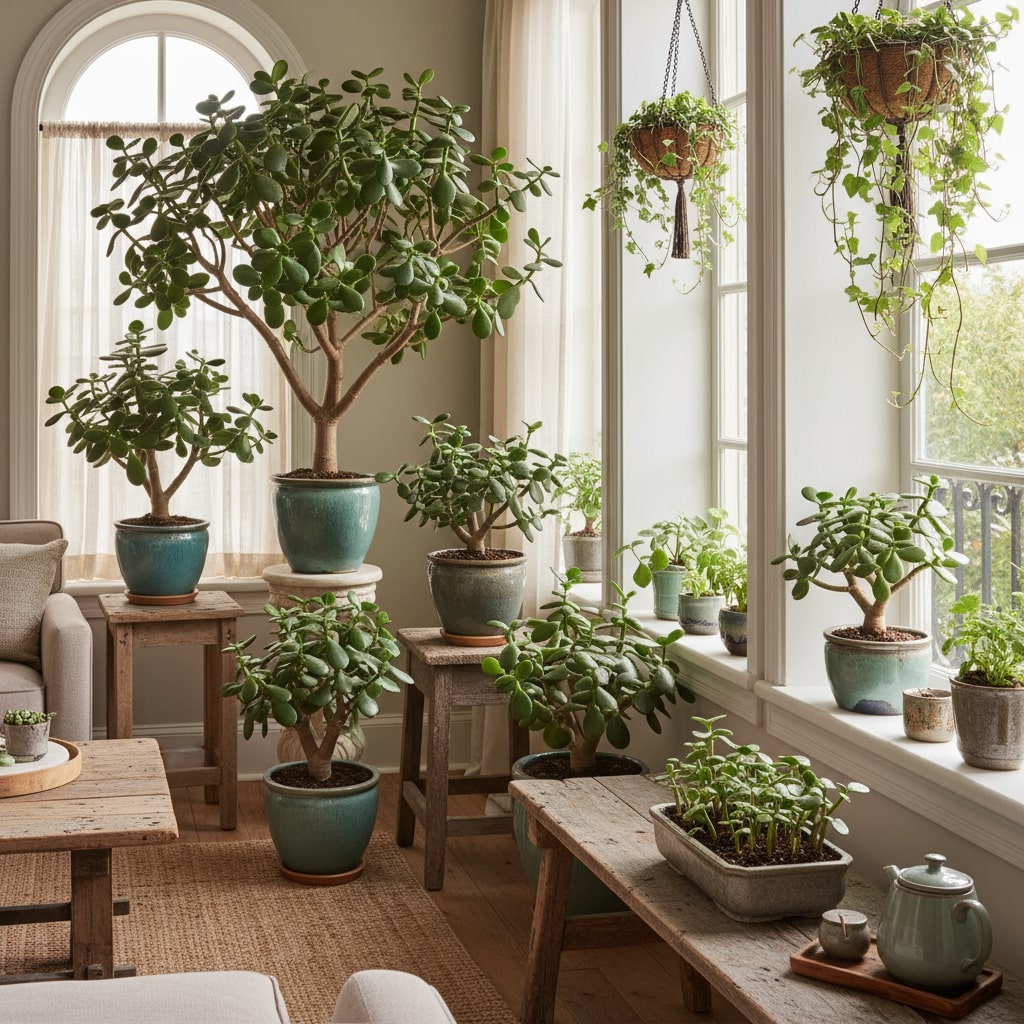
Jade Plant Watering Mistakes to Avoid
Jade plant watering mistakes to avoid include fixed schedules, using pots without drainage, misting leaves, and ignoring seasonal changes. These errors kill more jade plants than pests or diseases combined.
The Overwatering Trap
Fixed schedules ignore seasonal changes. Summer in Delhi requires weekly watering, but winter extends that to monthly. Your jade plant’s water needs vary with temperature, humidity, and light exposure.
Overwatering is the most common mistake that leads to soggy soil and potentially root rot. Always check the soil’s dryness before watering. The idea is to let the potting mix dry completely between watering cycles.
Using pots without drainage holes is a recipe for root rot. Water has nowhere to escape, creating permanently soggy conditions. Always drill holes if your favorite pot lacks them, or use it as an outer decorative sleeve with a practical nursery pot inside.
Letting plants sit in water-filled saucers overnight suffocates roots. After watering, wait 3-5 minutes for excess water to drain, then empty the saucer completely. Avoid letting the plant sit in water by always emptying the saucer beneath the pot.
Misting leaves like tropical plants is a terrible mistake with jade plants. They’re from arid regions, not rainforests. Misting encourages fungal spots and does absolutely nothing beneficial.
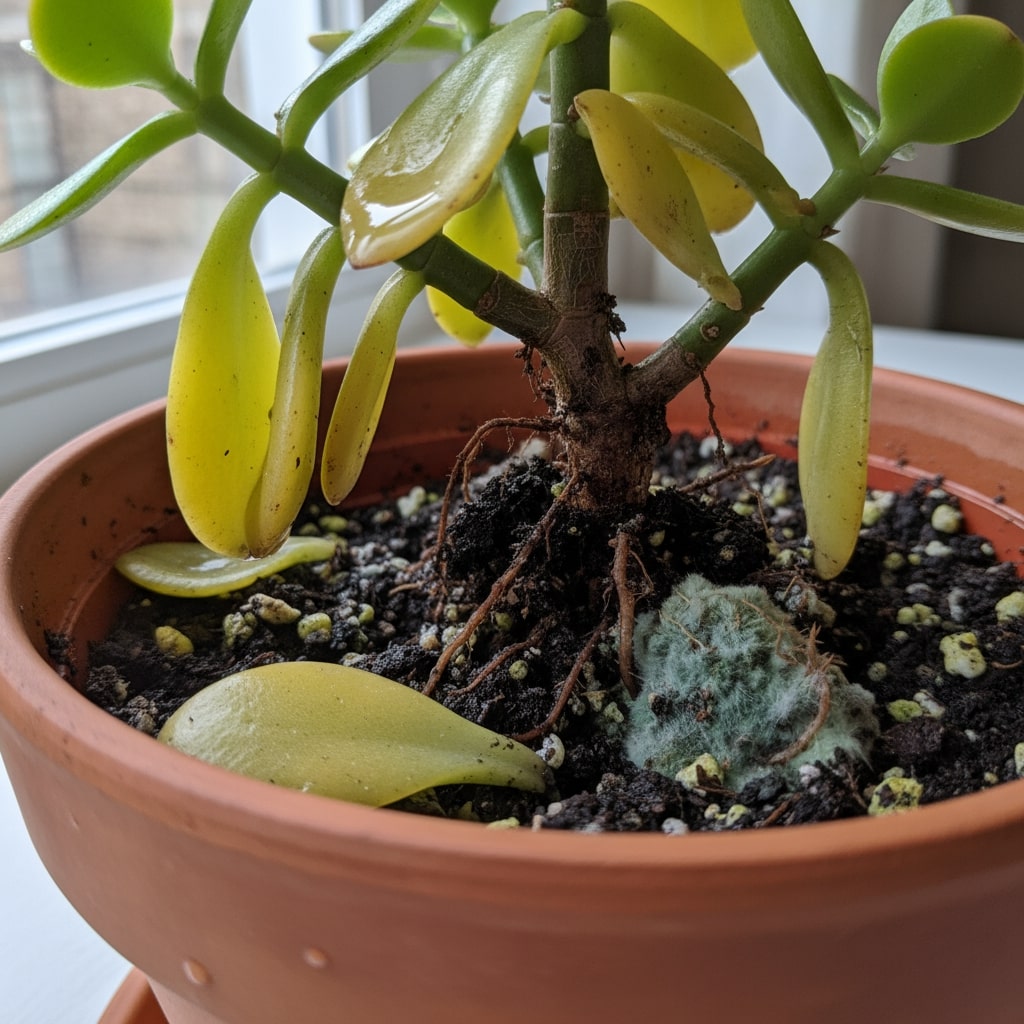
Wrong Soil and Container Choices
Regular garden soil retains too much moisture for succulents. Jade plants require fast-draining soil that dries within 5-7 days. Mix regular potting soil with perlite and coarse sand for proper drainage.
Dense potting mix without perlite or sand stays waterlogged. Adding some perlite makes the soil a little bit light and airy, preventing water retention issues.
Plastic pots in humid climates trap moisture longer than necessary. During Mumbai’s monsoon (June-September), jade plants in plastic pots develop fungal issues more easily. Terracotta pots allow excess moisture to evaporate through porous walls.
Oversized pots hold excess water around roots. Choose pots only 2 inches larger than the root ball. Extra soil stays wet for weeks, creating root rot conditions even with correct watering frequency.
Not sterilizing pruning tools before cutting can introduce microbes. Remember to wash and sterilize the tools before you prune a jade plant.
💡 Quick Tip: Write down your watering dates in a small notebook near your plants. If you’re watering more than twice monthly in winter, you’re overdoing it.
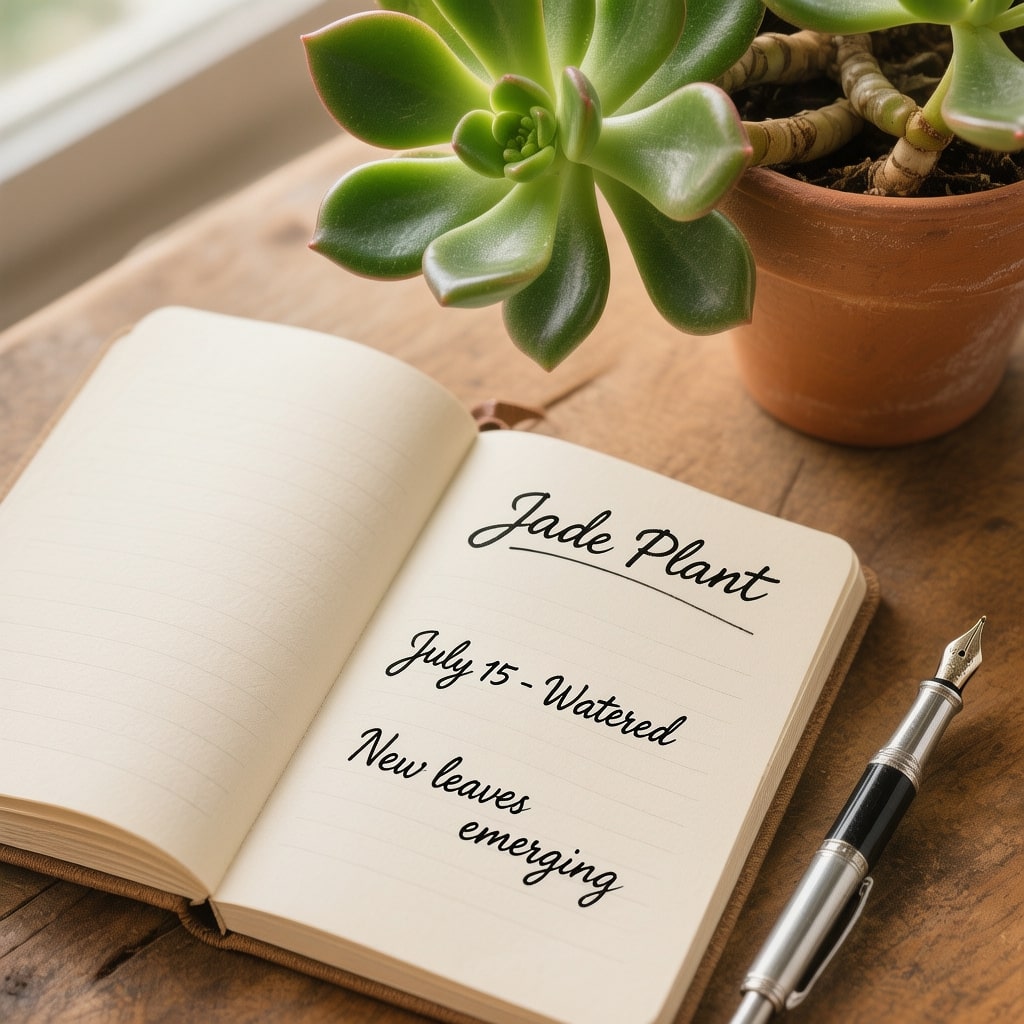
Inconsistent Watering Patterns
Inconsistent watering can stress the plant, leading to problems. Try to maintain a somewhat consistent watering approach, adjusting as needed based on the plant’s growth cycle and environmental changes.
Watering too often pushes too much water to the leaves and they can stop growing. Overwatering can also cause the cells of the leaves to rupture, which is called edema. This happens when the roots take up more water faster, causing imbalances.
Underwatering, while less dangerous, can stress the plant if left dry for too long. This leads to shriveled leaves and stunted growth. However, it’s always better to underwater than overwater jade plants.
Ignoring plant signals leads to preventable problems. Yellowing leaves usually indicate overwatering. Leaf drop can result from sudden changes in temperature or watering routine. Leggy growth means the plant might not be getting enough sunlight.

How Much Water Does a Jade Plant Need in Winter
How much water does a jade plant need in winter? Jade plants need 60-70% less water in winter, typically once every 3-4 weeks instead of weekly. From November to February, these succulents enter semi-dormancy, dramatically reducing their water consumption and growth rate.
Understanding Winter Dormancy
Growth slows significantly from November to February across North India. During these months, jade plants barely produce new leaves. This dormancy is natural — the plant conserves energy during cold, low-light conditions.
Water requirements drop by 60-70% compared to summer. If you watered every 7 days in August, extend that to 21-28 days in January. Water jade plants thoroughly in spring and summer when actively growing, but reduce significantly in winter.
Frequency in winter: Once every 3-4 weeks works for most indoor environments with heating. In unheated rooms that drop below 15°C at night, extend to 5-6 weeks. The soil should stay slightly drier during cold months.
Don’t follow a set schedule in winter — look for signs the plant needs water. Check for soft wrinkly leaves and very dry soil pulling away from pot edges. These are clear indicators it’s time to water.
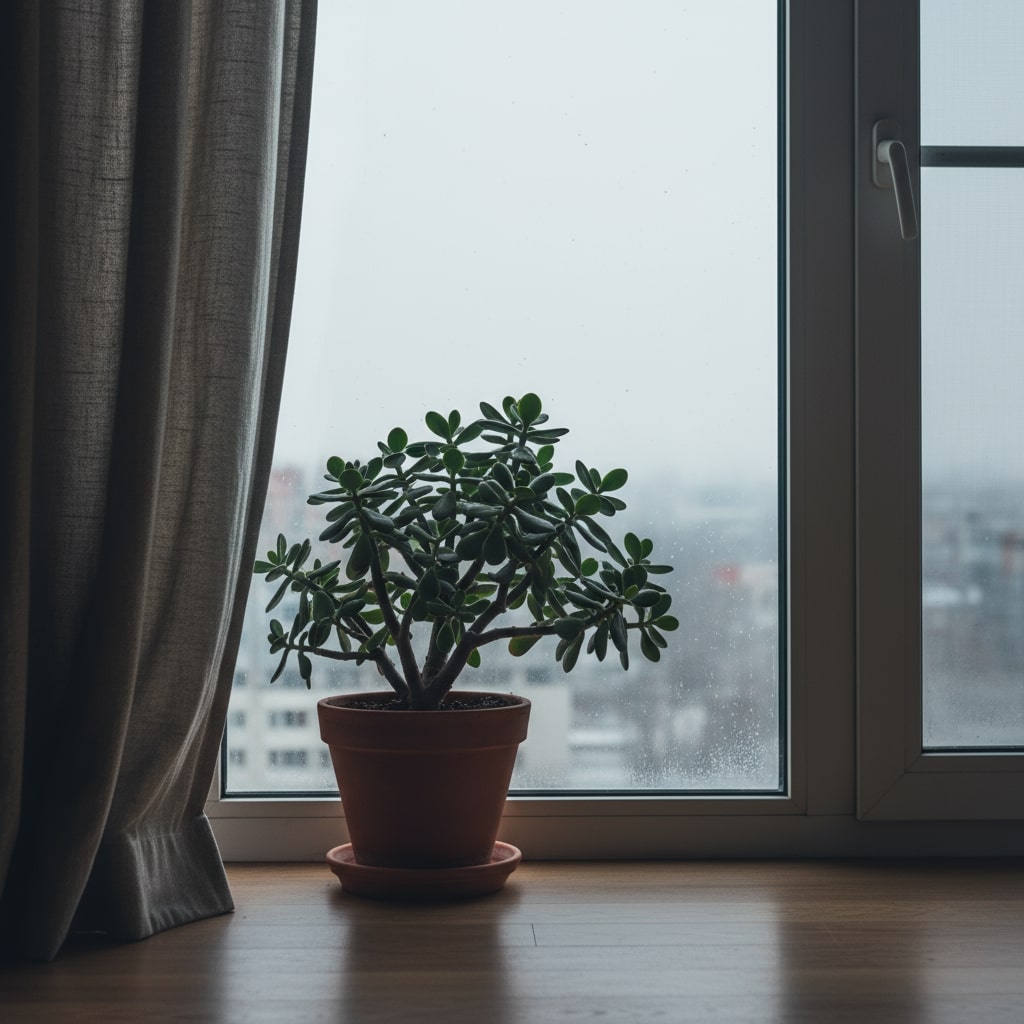
Winter Light and Water Connection
Less sunlight means slower water consumption. Winter days are shorter and cloudier across India. Even south-facing windows receive 30% less light intensity from December to January.
Leaves won’t absorb moisture as quickly when photosynthesis slows. The entire plant’s metabolism drops during low-light periods. Overwatering during this phase creates perfect conditions for fungal growth.
Risk of root rot increases with overwatering in winter because cool, damp soil remains wet longer. Check soil deeper (3 inches) before deciding to water. Use a bamboo skewer inserted to pot bottom — if it comes out damp, wait another week.
Maintain temperatures between 18-24°C during the day and slightly cooler at night. Avoid sudden temperature drops that stress the plant.
💡 Quick Tip: Use lukewarm water in winter — cold water shocks roots and slows nutrient uptake even further.

Regional Winter Watering Variations
North India (Delhi, Punjab, Haryana): Water minimally from November-February. The soil can stay dry for 4 weeks without harm. Indoor heating also dries air, so monitor for wrinkled leaves indicating actual thirst.
South India (Bangalore, Chennai, Hyderabad): These cities don’t experience true winter. Maintain a moderate reduction — if you watered every 10 days in summer, extend to 14-17 days in “winter” months. Growth continues year-round in these climates.
Coastal areas (Mumbai, Kolkata, Goa): Monitor monsoon humidity carefully. Winter months see reduced rainfall but still maintain humidity. Reduce watering frequency but watch for fungal issues. Mumbai jade plants need watering every 2-3 weeks in winter.
Hill stations (Shimla, Ooty, Darjeeling): Extra care needed with indoor heating systems that create desert-dry air. Despite cold temperatures outside, heated rooms can dry soil quickly. Check soil weekly in heated environments.
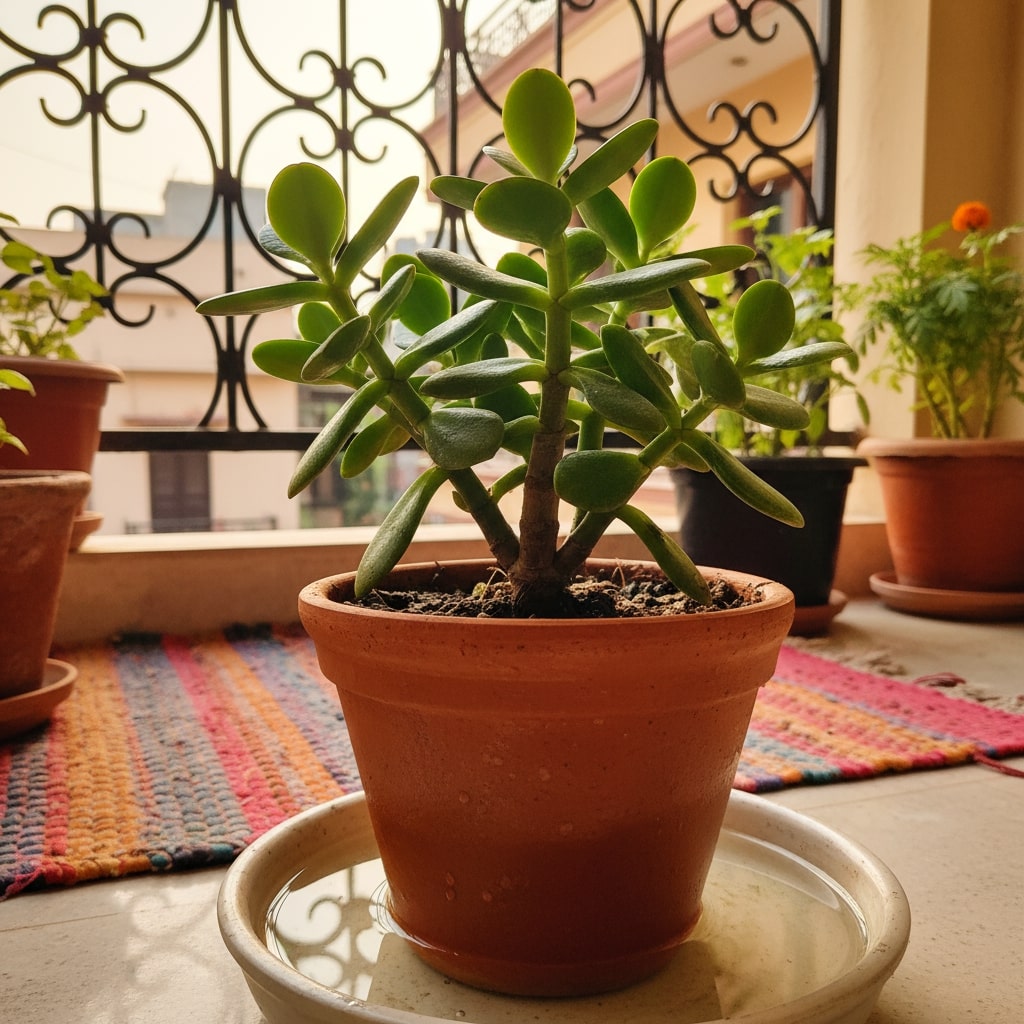
Sustainable Jade Plant Watering Practices
Jade plant care naturally aligns with eco-friendly gardening because these succulents use minimal water. One jade plant uses 80% less water than regular houseplants annually.
Water-Saving Methods
Reuse RO waste water instead of dumping it down the drain. Most Indian urban homes have RO water purifiers that waste 3-4 liters for every liter purified. Jade plants tolerate slightly higher TDS (300-500 ppm works fine).
Rainwater harvesting during monsoons gives you free, chlorine-free water that plants prefer. Keep drums on your balcony during monsoon months (June-September). This stored rainwater lasts through October-November.
Choose terracotta over plastic pots for sustainability benefits. Terracotta is biodegradable, lasts 10+ years with care, and its breathable walls reduce overwatering risk significantly.
Bottom watering method eliminates water waste. Place your jade plant pot in a tray with 2-3 inches of water for 10 minutes. The plant absorbs exactly what it needs — no runoff, no waste.
Collect AC condensation water for your jade plant — it’s distilled and chlorine-free! A running AC produces 5-10 liters daily during summer.
Understanding sustainable plant care helps both your garden and the environment. Learn more about water-efficient gardening practices in our comprehensive guide: Why is Sustainable Gardening Important.
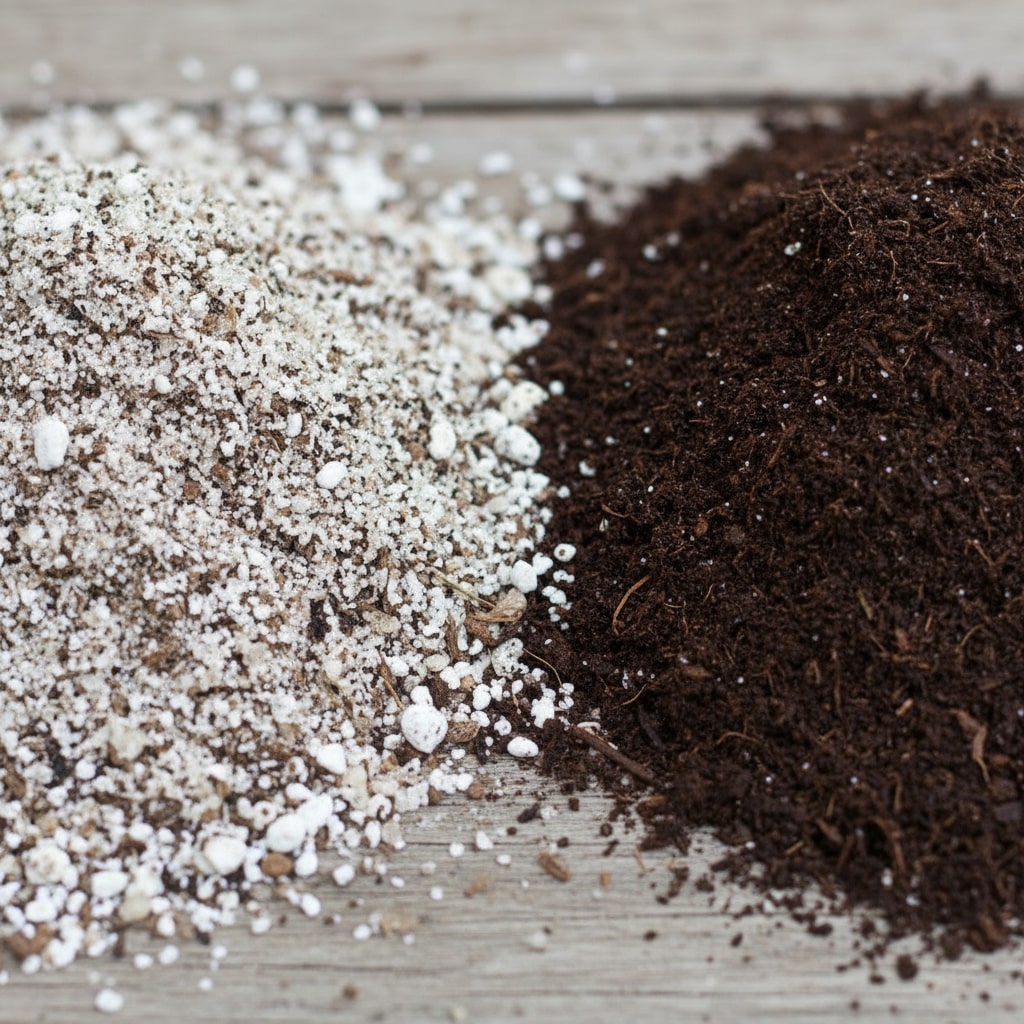
Frequently Asked Questions
Can I use tap water for my jade plant?
How do I know when my jade plant needs water?
Why are my jade plant leaves turning yellow?
Should I mist my jade plant leaves?
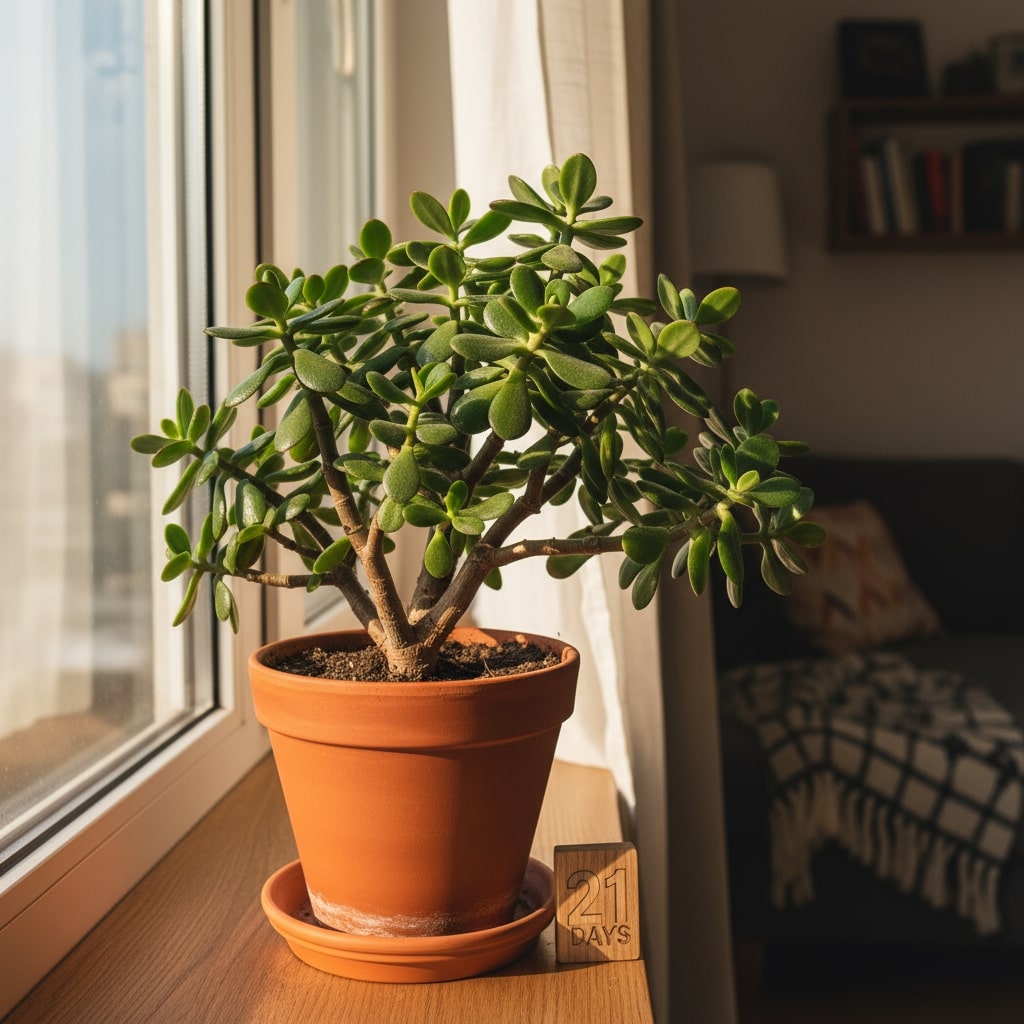
Your Jade Plant Success Formula
After five years of growing jade plants across different Indian cities, successful jade plant care boils down to five core principles:
Check soil before every watering — never follow fixed schedules. Your finger or moisture meter tells you exactly when to water. This single habit eliminates 80% of beginner mistakes.
Use the soak and dry method — the best way to water jade plant indoors. Water deeply until it drains from the bottom holes, then wait until the soil is completely dry. This encourages strong root development.
Place in optimal locations — where to place jade plant in home directly impacts its health. East-facing windows or south-facing balconies with 4-6 hours of bright, indirect sunlight work perfectly. Living rooms, entrances, and office desks are ideal spots according to Vastu.
Avoid common watering mistakes — overwatering, wrong pots, leaf misting, and ignoring seasonal changes. These jade plant watering mistakes to avoid kill more plants than pests or diseases combined.
Reduce watering dramatically in winter — how much water does a jade plant need in winter? About 60-70% less, typically once every 3-4 weeks. Winter dormancy is natural and necessary for plant health.
Remember, jade plants are forgiving companions that teach patience and observation. Start with these jade plant watering tips, watch your plant’s response, and adjust accordingly.
Ready to transform your flat into a thriving indoor jungle? 🌿 Explore more beginner-friendly guides, seasonal care tips, and sustainable gardening hacks on FlatGardening.com — where small spaces meet big green dreams!
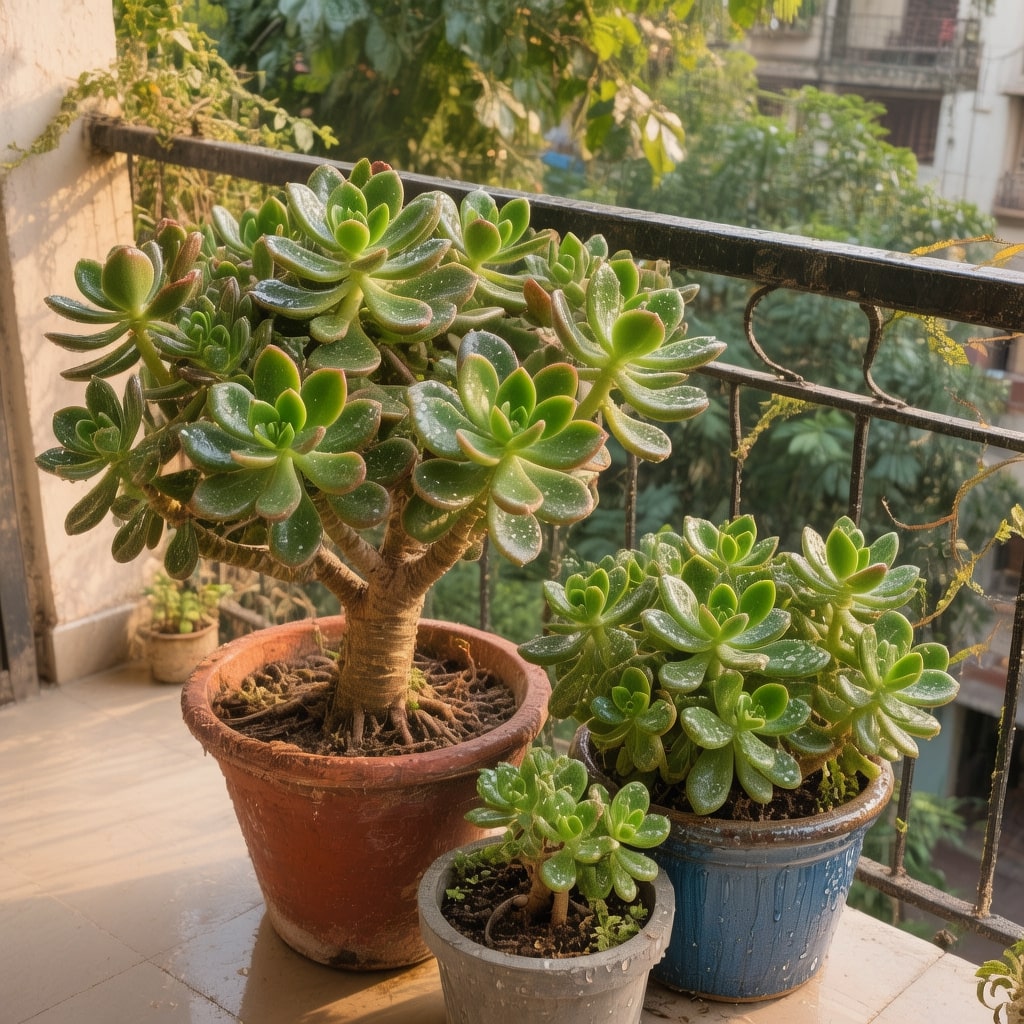
Author Bio
Written by Zaid Ansari, founder of FlatGardening.com, passionate about helping Indian apartment gardeners create thriving indoor green spaces. With 5+ years of hands-on experience helping urban gardeners transform balconies and small spaces into green havens, Zaid specializes in making indoor gardening accessible, sustainable, and foolproof for busy Indian professionals. Connect with Zaid for personalized gardening advice and discover how even the smallest apartment can become a lush indoor garden.
Pingback: Spider Plant Watering Tips: 1 Mistake Kills Yours 🌿- 2025